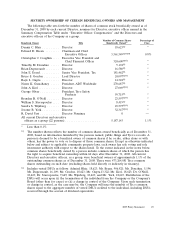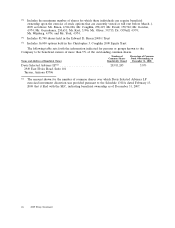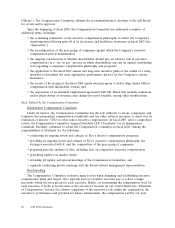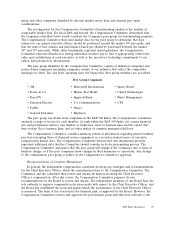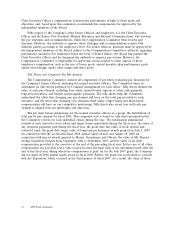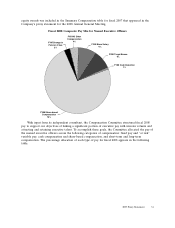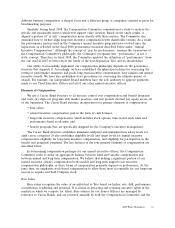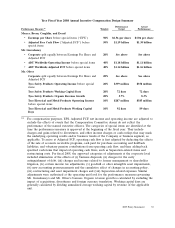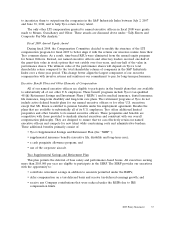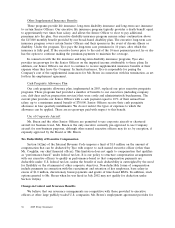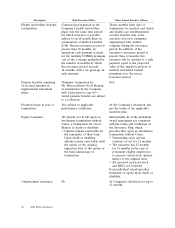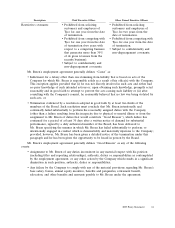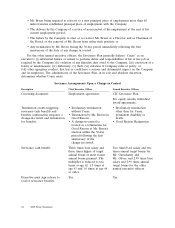ADT 2008 Annual Report Download - page 50
Download and view the complete annual report
Please find page 50 of the 2008 ADT annual report below. You can navigate through the pages in the report by either clicking on the pages listed below, or by using the keyword search tool below to find specific information within the annual report.different business composition, a sharper focus and a different group of companies counted as peers for
benchmarking purposes.
Similarly, during fiscal 2008, the Compensation Committee commissioned a study to analyze the
specific and measurable metrics which best support value creation. Based on the study results, it
aligned a portion of ‘‘at risk’’ compensation more directly with these metrics, The Committee also
examined how to further align long-term incentive compensation with shareholder returns. As a result,
the performance metrics used in the Company’s annual incentive programs have evolved since the
Separation, as reflected in the fiscal 2008 performance measures described below under ‘‘Annual
Incentive Compensation.’’ Although the concept of ‘‘pay for performance’’ remains the cornerstone of
the Compensation Committee’s philosophy, the Committee recognizes that ‘‘performance’’ is not a
static concept. Therefore, in fiscal 2008, the Committee updated the definition of ‘‘performance’’ from
the one used in 2007 to better meet the needs of the post-Separation Tyco and its shareholders.
Our ability to successfully implement our compensation philosophy depends on the governance
structure that supports it. Accordingly, we have established disciplined procedures for overseeing the
setting of performance measures and goals, long-term incentive compensation, base salaries and annual
incentive awards. We have also established strict procedures for overseeing the ultimate payout of
awards. For example, our independent Board members have the sole authority to approve payments
made to our Chief Executive Officer and all of our other named executive officers.
Elements of Compensation
We use a Career Band structure to (i) increase control over compensation and benefit programs
and costs, (ii) align our programs with market practices, and (iii) provide internal pay equity across all
of our businesses. The Career Band structure incorporates four primary elements of compensation:
• base salary;
• annual incentive compensation paid in the form of cash bonuses;
• long-term incentive compensation, which includes stock options, time-vested stock units and
performance-based stock units; and
• benefit programs that are specifically designed for the Company’s executive management.
The Career Band structure establishes minimum, midpoint and maximum base salary levels for
eight career categories. It also establishes eligibility levels and target levels for annual incentive
compensation, eligibility for long-term incentive compensation, and eligibility for participation in the
benefit and perquisite programs. The key features of the four primary elements of compensation are
described below.
In determining compensation packages for our named executive officers, the Compensation
Committee seeks to strike an appropriate balance between fixed and variable compensation and
between annual and long-term compensation. We believe that making a significant portion of our
named executive officers’ compensation both variable and long-term supports our executive
compensation philosophy, as these forms of compensation primarily depend on performance. At the
same time, we emphasize stock-based compensation to allow those most accountable for our long-term
success to acquire and hold Company stock.
Base Salary
Base salary recognizes the value of an individual to Tyco based on his/her role, skill, performance,
contributions, leadership and potential. It is critical in attracting and retaining executive talent in the
markets in which we compete for talent. Base salaries for our Senior Officers are managed by
reference to Career Bands, and are reviewed annually by both the Compensation Committee and the
2009 Proxy Statement 33




